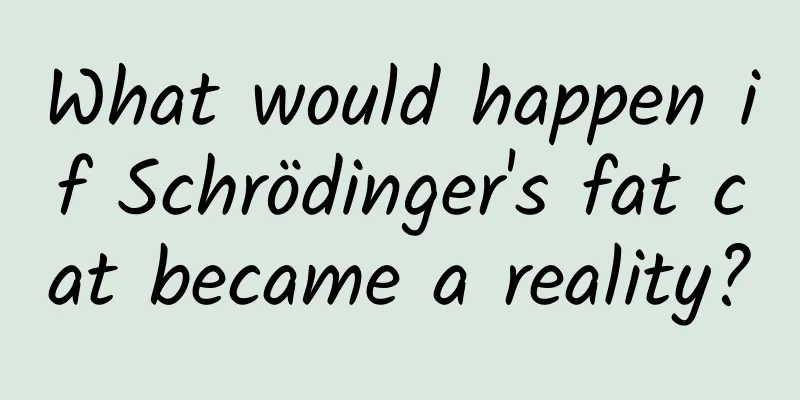What would happen if Schrödinger's fat cat became a reality?

|
Turning the famous idea of Schrödinger's cat into reality and realizing the macroscopic quantum superposition state can allow us to more deeply understand the boundary between the microscopic world and the macroscopic world. Written by | Yi Er San (Postdoctoral Fellow in Quantum Information) Quantum properties that go beyond everyday experience, such as quantum superposition and entanglement, have been repeatedly confirmed in experiments in the microscopic world. While deepening people's understanding of the laws of nature, they have also become the basis of quantum information technology. However, why are these phenomena difficult to observe in the macroscopic world? In 1935, Schrödinger proposed "Schrödinger's cat" - a "quantum cat" that is both "dead" and "alive" at the same time, which well reflects the confusion that may arise when generalizing quantum properties to macroscopic objects. Of course, there is no cat that is both dead and alive in reality, so how can macroscopic matter embody quantum properties? Some people would say that quantum mechanics does not apply to macroscopic matter, so where is the boundary between the macroscopic world and the microscopic world? One way to clarify these issues is to start building a macroscopic object in a quantum superposition state. How to achieve macroscopic superposition? In fact, physicists have already successfully prepared superposition states of relatively macroscopic matter. To realize the Schrödinger cat state of the traditional thought experiment, a classical property needs to be entangled with a microscopic property. The experimental idea is as follows: two microscopic quantum properties, such as two atomic energy levels, two spin directions (recorded as up and down), etc., are used as decayed and undecayed atoms in the Schrödinger cat thought experiment; two different macroscopic properties, such as two different modes of motion of an object (recorded as a and b), are used as the death and life of the cat; by coupling the two properties, the following evolution can be achieved: when the microscopic is up (down), the macroscopic is a (b). According to the Schrödinger equation, if the microscopic properties are prepared as a quantum superposition state of up and down, then the evolution will seem to proceed in parallel in two branches (this figurative metaphor is similar to the many-worlds interpretation, but we don’t really know how evolution occurs), and finally form two coherent superposition branches of "up a" and "down b". The interference of the two branches can be observed to confirm that the macroscopic properties are indeed in a quantum superposition state. Starting with the earlier single-ion moving state Schrödinger's cat[1], a series of increasingly "large" cats have been prepared. Here, "large" has two meanings. One is that the separation scale of macroscopic characteristics is large. For example, when the macroscopic characteristic is spatial position (according to quantum mechanics, an object can be in different spatial positions at the same time), the spatial distance between the two branches is large. Recent studies have used cold atoms to prepare superposition states separated by half a meter[2], but this research is still controversial[3]. On the other hand, it refers to the large mass of the material carrier of the macroscopic characteristic (jokingly called Schrödinger's fat cat), such as the spatial superposition state of atomic clusters and macromolecules[4]. In a recent work, researchers claimed to have prepared an entangled state of the life form "water bear" and a superconducting quantum bit[5], that is, the water bear is in a macroscopic superposition state of two different states at the same time. Of course, this result has also been questioned by many parties[6], and some people say that "it is very likely to win the next Ig Nobel Prize." Observing quantum superposition at a macroscopic scale is not only difficult to achieve experimentally, but is also a controversial topic in theory [7]. The current mainstream view is that macroscopic objects are more coupled to the environment, and the resulting decoherence effect makes it difficult to maintain macroscopic superposition states. There is also a view that standard quantum mechanics is only an approximation of a more general and profound theory, which is no longer applicable at a macroscopic scale, and that macroscopic superposition states will be destroyed by hypothetical effects such as trace dynamics or gravitational collapse. At least for now, the academic community believes that making Schrödinger's cat "bigger and fatter" will help explore these unknown areas. Schrodinger cat state of macroscopic mechanical oscillator When "raising" Schrödinger's fat cat, some physicists took a different approach and used mechanical oscillators. One of the top ten breakthroughs in Physics World in 2021 [8-10] was to entangle the motion modes of two mechanical oscillators, while also achieving a superposition state of the oscillators in different motion modes. Unlike microscopic particles such as atoms and electrons, mechanical oscillators are closer to macroscopic objects because they themselves are composed of a large number of atoms. For example, the study of 100 picograms (~1012 atoms) of oscillators in [10]. Studying the quantum properties of such objects is more likely to further understand the boundary between quantum and classical. In a study published in Science in April 2023 [11], researchers successfully placed a 16-microgram (~10^17 atoms) mechanical oscillator in a quantum superposition of two states of motion. This is the “fattest” Schrödinger’s cat ever created. Figure 1 Schematic diagram of the experimental setup. The oscillating crystal can be in different motion modes. It is coupled to the superconducting qubit (bottom right) via the piezoelectric effect | Image credit: Yiwen Chu / ETH Zurich. In this work, the experimental device is a high-overtone bulk acoustic-wave resonator (HBAR) and a superconducting qubit that are coupled to each other. The oscillating crystal represents the macroscopic cat, and the decaying superconducting qubit represents the decaying atom. The superconducting qubit can be in two states at the same time, up and down, corresponding to decay and non-decay. The oscillating crystal can be in different motion modes, such as two oscillation modes a and b with the same frequency and opposite phases, representing dead and alive respectively. The oscillation mode of the crystal is coupled to the electric field of the quantum bit through the piezoelectric effect. In other words, the electric field of the quantum bit is coupled to the electric field generated by the crystal oscillation. The change of the quantum state of the former corresponds to the movement of the crystal (the system can be described by the Jaynes-Cummings model that describes the coupling between the quantum bit and the phonon). Therefore, the quantum superposition of the upper and lower states is mapped to the quantum superposition of the a and b oscillation modes of the crystal. The crystal is in two different motion modes at the same time, that is, a "dead and alive cat" is realized. In particular, due to the opposite oscillation phases, the atoms in the crystal will be at the highest and lowest oscillation points at the same time at a certain moment, which is also a phenomenon not seen in the classical world. In order to verify that the motion mode is indeed in a quantum superposition state, the crystal motion cannot be directly observed "roughly". Because this will obtain the a or b mode with a probability, and it is impossible to judge whether it is in a quantum superposition of a and b, or a classical mixed state of "several a times and several b times". The researchers used the standard method in quantum information to perform quantum state tomography on the motion state, that is, to obtain all the information of the system quantum state by observing each non-commutative observation separately. The results not only show that the two branches a and b of the superposition state are distinguishable different motion states, but also clearly show the interference fringes in the phase space caused by the quantum coherent superposition of the two branches. It was finally confirmed that the total mass of the atoms prepared in the Schrödinger cat state is about 16.2 micrograms, and the maximum spatial separation scale is about 2.1×10^(-18) meters. Although the separation is smaller than the scale of an atom, the experiment can still distinguish the two motion modes; and the macroscopic manifestation is that the mass of the object in the superposition state is large (reaching the microgram level). In addition, the researchers also prepared a series of cat states with different separation scales by regulating and manipulating field strength, and studied their decoherence behavior. The results show that the decoherence rate increases with the increase of scale, which is consistent with theoretical expectations. Some prospects Obviously, the exploration of macroscopic quantum properties is an "endless frontier". In terms of the foundations of quantum mechanics, the problem of quantum measurement has always been controversial, partly because it involves the entanglement between the microscopic quantum system and the measurement device (macroscopic) and the surrounding environment. Studying macroscopic superposition states can help understand the above problems; it can also help to test some theories that go beyond standard quantum mechanics. From the perspective of quantum technology, future practical and large-scale quantum computers require a large number of quantum bits in controllable quantum states, and the study of macroscopic quantum properties is expected to provide a reference for this. At the same time, similar macroscopic quantum states are expected to be applied to continuous variable quantum information processing, quantum error correction, quantum sensing of gravitational waves and other fields. With further development in this direction, it is expected that macroscopic superposition states with large mass and spatial separation will be prepared in the future, which will help explore quantum gravitational phenomena such as entanglement mediated by gravity [12]. References [1] Science 380, 274-278 (2023). [2] Science 272, 1131-1136 (1996). [3] Nature 528, 530-533 (2015). [4] Nature 537, E1-E2 (2016). [5] Nat. Phys. 15, 1242-1245 (2019). [6] New J. Phys. 24, 12302 (2022). [7] https://phys.org/news/2021-12-peers-dispute-tardigrades-entangled-qubits.html. [8] Rev. Mod. Phys. 85, 471-527 (2013). [9] https://physicsworld.com/a/physics-world-announces-its-finalists-for-the-2021-breakthrough-of-the-year/ [10] Science 372, 622-625 (2021). [11] Science 372, 625-629 (2021). [12] Phys. Rev. Lett. 119, 240401 (2017). This article is supported by the Science Popularization China Starry Sky Project Produced by: China Association for Science and Technology Department of Science Popularization Producer: China Science and Technology Press Co., Ltd., Beijing Zhongke Xinghe Culture Media Co., Ltd. Special Tips 1. Go to the "Featured Column" at the bottom of the menu of the "Fanpu" WeChat public account to read a series of popular science articles on different topics. 2. Fanpu provides a function to search articles by month. Follow the official account and reply with the four-digit year + month, such as "1903", to get the article index for March 2019, and so on. Copyright statement: Personal forwarding is welcome. Any form of media or organization is not allowed to reprint or excerpt without authorization. For reprint authorization, please contact the backstage of the "Fanpu" WeChat public account. |
<<: The nails are the "barometer" of health, check yourself now!
>>: Are there any healthy snacks that won’t make you fat? The truth →
Recommend
Can Huawei HMS replace Google's GMS? Check out the test by foreign media
introduction [[319525]] Google's GMS? Check o...
The longest-lived bubble on the ground! It can last for nearly half an hour without bursting
Produced by: Science Popularization China Author:...
Different "aliens" were found on the moon's surface, which may provide them with water
Are there "aliens" on the surface of th...
iPhone iPad productivity boost! Let's play with Safari extensions
Many people try to use iOS devices (including iPa...
Unveiling the secrets of the rainforest's first camouflage master, the "dead leaf butterfly"
The dead leaf butterfly, commonly known as the &q...
Are hazelnuts and acorns "relatives"? I only found out after eating them for so many years...
Hazelnuts are a nut that many people like to eat,...
How much does it cost to make the Tieling baking utensils mini program? Tieling baking utensils applet production price inquiry
There are two types of Tieling baking utensils We...
Google releases Fuchsia specification for its non-Linux operating system
Google has revealed details of its non-Linux oper...
China Association of Automobile Manufacturers: 2020 Automobile Production and Sales Data and Automobile Industry Operation
The China Association of Automobile Manufacturers...
Wedding photography, second-tier e-commerce and other industries information flow delivery cases and data references
Today we are going to talk about the delivery of ...
In-depth study of JavaScript objects
In JavaScript, everything except the five primiti...
#千万IP创科学热门#丨Minnan flower bricks, can cement also bloom?
Minnan tiles are traditional architectural decora...
Galaxy Note 5 battery life/charging results are out: amazing!
A few days ago, Samsung held a press conference i...
Is the Apple Watch enough to start a revolution on the wrist?
"If you do something brilliantly, then you s...
Three questions about users: Who are the users? Where do users come from? What does the user want to do?
There are three ultimate questions in philosophy:...



![[Online Event] Learn to develop games with Cocos2d-lua in two hours](/upload/images/67ebf0ad8f16d.webp)





